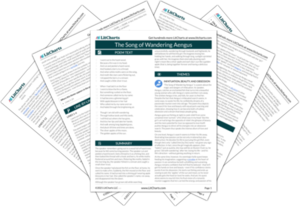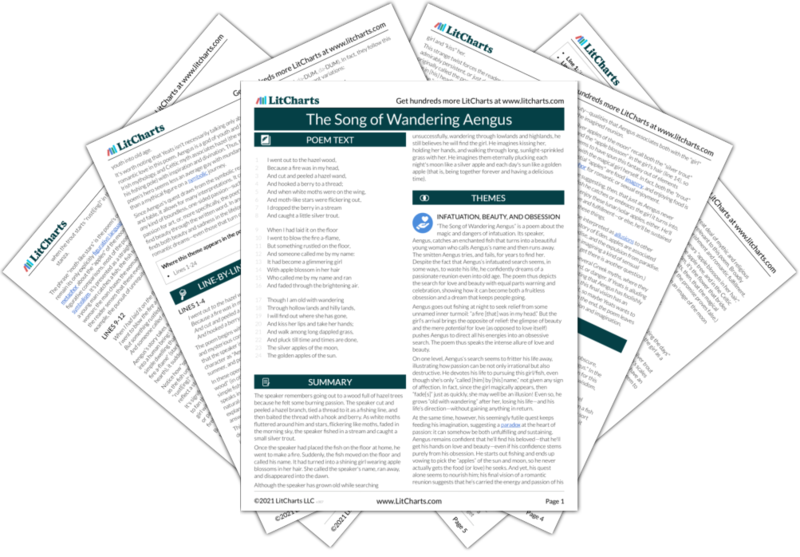

The Song of Wandering Aengus Summary & Analysis by William Butler Yeats
- Line-by-Line Explanation & Analysis
- Poetic Devices
- Vocabulary & References
- Form, Meter, & Rhyme Scheme
- Line-by-Line Explanations

First printed in 1897 and collected in The Wind Among the Reeds (1899), W. B. Yeats's "The Song of Wandering Aengus" is a dramatic monologue about burning and thwarted passion. Written in the voice of Aengus (a god of love and youth in Irish mythology), it tells the tale of a magical fish that turns into a beautiful girl and runs away. The infatuated Aengus wanders the earth in pursuit of this girl, growing old but never giving up his search. As a kind of miniature fable, the poem suggests how unrequited love—or any other unattainable dream—can both exhaust a person's energies and nourish a person's imagination.
- Read the full text of “The Song of Wandering Aengus”

The Full Text of “The Song of Wandering Aengus”
1 I went out to the hazel wood,
2 Because a fire was in my head,
3 And cut and peeled a hazel wand,
4 And hooked a berry to a thread;
5 And when white moths were on the wing,
6 And moth-like stars were flickering out,
7 I dropped the berry in a stream
8 And caught a little silver trout.
9 When I had laid it on the floor
10 I went to blow the fire a-flame,
11 But something rustled on the floor,
12 And someone called me by my name:
13 It had become a glimmering girl
14 With apple blossom in her hair
15 Who called me by my name and ran
16 And faded through the brightening air.
17 Though I am old with wandering
18 Through hollow lands and hilly lands,
19 I will find out where she has gone,
20 And kiss her lips and take her hands;
21 And walk among long dappled grass,
22 And pluck till time and times are done,
23 The silver apples of the moon,
24 The golden apples of the sun.
“The Song of Wandering Aengus” Summary
“the song of wandering aengus” themes.

Infatuation, Beauty, and Obsession
- See where this theme is active in the poem.
Line-by-Line Explanation & Analysis of “The Song of Wandering Aengus”
I went out to the hazel wood, Because a fire was in my head, And cut and peeled a hazel wand, And hooked a berry to a thread;

And when white moths were on the wing, And moth-like stars were flickering out, I dropped the berry in a stream And caught a little silver trout.
When I had laid it on the floor I went to blow the fire a-flame, But something rustled on the floor, And someone called me by my name:
Lines 13-16
It had become a glimmering girl With apple blossom in her hair Who called me by my name and ran And faded through the brightening air.
Lines 17-20
Though I am old with wandering Through hollow lands and hilly lands, I will find out where she has gone, And kiss her lips and take her hands;
Lines 21-24
And walk among long dappled grass, And pluck till time and times are done, The silver apples of the moon, The golden apples of the sun.
“The Song of Wandering Aengus” Symbols

- See where this symbol appears in the poem.

Silver Trout

“The Song of Wandering Aengus” Poetic Devices & Figurative Language
- See where this poetic device appears in the poem.
Parallelism
Alliteration, juxtaposition, “the song of wandering aengus” vocabulary.
Select any word below to get its definition in the context of the poem. The words are listed in the order in which they appear in the poem.
- On the wing
- Apple blossom
- See where this vocabulary word appears in the poem.
Form, Meter, & Rhyme Scheme of “The Song of Wandering Aengus”
Rhyme scheme, “the song of wandering aengus” speaker, “the song of wandering aengus” setting, literary and historical context of “the song of wandering aengus”, more “the song of wandering aengus” resources, external resources.
The Poet's Life and Work — Read a short bio of Yeats, along with other Yeats poems, at Poets.org.
The Poem Read Aloud — Hear a reading of the poem by actor Michael Gambon.
"Aengus" in Song — Listen to a 1971 adaptation of the poem by folk singer Donovan.
Yeats, Nobel Laureate — Browse an exhibit on Yeats, winner of the 1923 Nobel Prize in Literature, at Nobel.org.
The Many Sides of Yeats — Read the Poetry Foundation's introduction to the various phases of Yeats's career.
Yeats Reads His Work — Listen to a rare recording of W. B. Yeats reading his poetry aloud.
LitCharts on Other Poems by William Butler Yeats
Adam's Curse
Among School Children
An Irish Airman Foresees his Death
A Prayer for my Daughter
Easter, 1916
In Memory of Eva Gore-Booth and Con Markievicz
Lapis Lazuli
Leda and the Swan
Sailing to Byzantium
September 1913
The Lake Isle of Innisfree
The Second Coming
The Wild Swans at Coole
When You Are Old
Ask LitCharts AI: The answer to your questions

The Song of Wandering Aengus Analysis
Symbols, imagery, wordplay, form and meter, sound check, what's up with the title, calling card, tough-o-meter, steaminess rating, tired of ads, logging out…, logging out....
You've been inactive for a while, logging you out in a few seconds...
W hy's T his F unny?
- Lesson Plans
- Teacher's Guides
- Media Resources
“The Song of Wandering Aengus” by W. B. Yeats

Loch Gill seen from nature trail running through Hazelwood Country Park, on the outskirts of Sligo, Ireland, and immortalized by W. B. Yeats in “The Song of Wandering Aengus.”
Wikimedia Commons
"I think a kind of half ballad, half lyric ... is the kind of poem I like best myself—a ballad that gradually lifts ... from circumstantial to purely lyrical writing. ... I only learnt that slowly and used to be content to tell stories . ... One must always have lyric emotion or some revelation of beauty…" —Letter from W.B. Yeats to Dora Sigerson (1899)
Teacher guide “The Song of Wandering Aengus” by W. B. Yeats includes information about the poem and discussion questions. Supplementary documents provide contextual background on Irish traditional sources including Celtic mythology and Irish aisling poetry.
On this Page:
About the Poem
Questions for discussion, questions for further discussion.
“The Song of Wandering Aengus”
I went out to the hazel wood, Because a fire was in my head, And cut and peeled a hazel wand, And hooked a berry to a thread; And when white moths were on the wing, And moth-like stars were flickering out, I dropped the berry in a stream And caught a little silver trout.
When I had laid it on the floor I went to blow the fire a-flame, But something rustled on the floor, And someone called me by my name: It had become a glimmering girl With apple blossom in her hair Who called me by my name and ran And faded through the brightening air.
Though I am old with wandering Through hollow lands and hilly lands, I will find out where she has gone, And kiss her lips and take her hands; And walk among long dappled grass, And pluck till time and times are done, The silver apples of the moon, The golden apples of the sun.
The Wind Among the Reeds, 1899. 4th ed. (London, 1903), 15–16. Available at Project Gutenberg .
An online version of the poem is also available on EDSITEment-reviewed Academy of American Poets.
William Butler Yeats wrote “The Song of Wandering Aengus” on January 31 sometime in the late 1890s. It was first printed in 1897 under the title "A Mad Song." The current title "The Song of Wandering Aengus" was applied when it was finally published in The Wind Among the Reeds (1899). These early collected poems displayed Yeats's mastery of the lyric form as well as his passion for Celtic mythology and Irish folklore, which were to fuel his poetic genius throughout his career.
“The Song of Wandering Aengus” is deceptively simple, yet it paints a haunting story containing many mythological allusions and nuanced levels of meaning. The speaker is an old man reminiscing about an event long ago when he was compelled to go out to cut a branch for fishing. With it, he caught a magical silver trout, which was then transformed into a vision of a “glimmering” maiden. The life-quest he set himself was to find this girl who called his name before she vanished.
In the poem, Yeats contrasts two realities: the earthly realm of ordinary life and the mystical otherworld of dreams. He wrestles with conflicting desires—the ongoing need to handle the practical things of life and the strong compulsion to follow one’s dreams. To express this conflict, Yeats employs a break in the middle of each stanza signaled by a semicolon or colon. This shift underlines the gap between the earthly, physical world and the mysterious, magical otherworld. It moves the reader from the concrete world of the particular to the abstract world of the universal.
For background on the life and work of the poet, see the EDSITEment-reviewed Poetry Foundation entry on “ W. B. Yeats ” and Stephen Watt's, “The Voice of Nationalism: One Hundred Years of Irish Theatre,” Humanities 20, no.1 (1999).
The seven questions in this worksheet can be adapted for use in a classroom discussion or literature circle and are aligned with Common Core literacy standards for grade 8. In whatever venue, make sure that students provide evidence from the poem in their answers. (See also the teacher version with suggested answers. )
- Question 5 discusses the terms below and their meanings from the EDSITEment literary glossary: assonance ; repetition ; alliteration ; consonance ; and meter .
- Question 7 references another poem about dreams also published in The Wind Among the Reeds , “ Aedh Wishes for the Cloths of Heaven .”
Five questions for further discussion are found in the accompanying worksheet . However, before delving deeper into the poem, you will need to read and discuss the information included in Traditional Irish Sources for “The Song of Wandering Aengus” with students. After reading this contextual background, the questions can be raised for discussion and/or used as a basis for writing activities. (See the teacher version with suggested answers ).
Note: Question 5 references the late 20th-century aisling by Seamus Heaney, " A Hazel Stick for Catherine Ann ,” in Opened Ground: Selected Poems, 1966–1996 (New York: Farrar, Straus and Giroux, 1998), 214.
Materials & Media
Wandering aengus: worksheet 1. questions for discussion, wandering aengus: worksheet 2. questions for further discussion, wandering aengus: traditional irish sources for “the song of wandering aengus”, wandering aengus: questions for discussion (teacher version), wandering aengus: questions for further discussion (teacher version), related on edsitement, twenty-one poems for ap literature and composition, twenty-one more poems for ap english, charles baudelaire: poète maudit (the cursed poet), chinua achebe’s things fall apart.
"The Song of Wandering Aengus" by W.B. Yeats: An Analysis

“The Song of Wandering Aengus”, from W.B. Yeats 1899 collection, The Wind Among the Reeds , is one of the best known of the Nobel prize-winning poet’s early works. Like much of Yeats’s work from this time, it draws heavily on Irish mythology, inextricably mixed with more personal themes from the poet’s life.
The deeply symbolic nature of Yeats’s poetry was influenced by three sources: Irish mythology, classical Greek mythology, and the occult symbolism he was exposed to when he joined the magical order known as The Golden Dawn in 1890. In Yeats’s early career, he was heavily involved in collecting Irish folklore, and this informs his poetry of the 1890s.
The Aengus of the title was a god of Irish mythology, one who stayed forever young and lived in a most marvelous palace where no one ever died, and where food and drink was always plentiful. This palace was called Brug na Boinne, and was situated on the banks of the River Boyne. He was also known as Aengus Og (“Aengus the Young”), among several variants.
One of the most famous tales about Aengus, and one that is partly reproduced by Yeats in the poem, involves his love for a young girl called Caer. He became sick with love for her having only seen her in a dream, and after years of searching, finally found her. Caer spent each year alternately as a swan or as a human girl. When Aengus found her, she was a swan, and he plunged into the water beside her and he too turned into a swan. Together they sang the most beautiful songs that put all who heard to sleep. After a year, Caer and Aonghus turned from swans back to their original form.
The obsessive love (“a fire was in my head”), the wandering in search of the briefly-glimpsed maiden, and the animal metamorphosis are common to the poem and the myth. However, in Yeat’s poem the metamorphosis involves a trout, not a swan – though both are related by the association with water. The trout-girl recalls the Irish myth of the maighdean mhara (“maidens of the sea”), who often bewitched men to fall in love with them.
But unlike the Aengus of legend, Yeat’s protagonist is, at the poem’s end, not united with his beloved. Also unlike Aengus, he has grown old. Therefore his expressions of optimism in the final verse ("I will find out where she has gone, and kiss her lips and take her hands") may allude to the afterlife, as in this life he has grown old with fruitless searching. Unlike the eternally young Aengus, Yeats's protagonist is affected by the passing of time. The bittersweet ending implies that he now awaits death, but trusts that in the afterlife he will find the love he has only glimpsed briefly. In death he will be forever young like Aengus.

William B. Yeats
The reference in the final lines to “silver apples of the moon” and “golden apples of the sun” has provoked many interpretations. One source may be the legend that in Aengus’s palace there were, as well as an un-emptying vessel of the best drink and a pig nicely roasted and always available to eat, three trees that always bore fruit. Yeats’s protagonist is again imagining himself in the palace of Aengus, immortal and beloved.
The sun and moon symbolism are important in occult circles. Yeats himself wrote about the lunar influence being the source of all thoughts that are of the community, of instinct and primal coconscious; and the solar influence being responsible for individual thoughts, and rationality.
This indicates that the final end of Aengus’s quest and wandering is the eating of both types of apple, meaning the perfect harmony of the two aspects of his being: his lunar self, which is more instinctual, of the earth and belonging to the collective unconscious, and his solar self, rational, intellectual, and disciplined. In this reading, the "glimmering girl" is not an individual at all, but an aspect of Yeats' psyche, the primitive, carefree aspect, which he is not yet able to access fully, being too "disciplined", too "intellectual".
Of course, the apple, recalling Book of Genesis, is often associated with the sensual, and plucking apples may be equated to enjoying the sensual aspects of life. Ultimately, all of these clues provide several ways of reading “The Song of Wandering Aengus”, and no one interpretation can be advanced as superior to the exclusion of others. Fundamentally, this poem is about the hero's quest that is a motif in so much mythology and literature. What the hero seeks is elusive and there is no logical reason to believe he will find it, but he continues to have faith, and this faith gives his life meaning.
The popularity of this poem is attested to by the number of times it has been set to music, by artists such as Judy Collins, Richie Havens, Donovan and Christy Moore.
- National Poetry Month
- Materials for Teachers
- Literary Seminars
- American Poets Magazine
Main navigation
- Academy of American Poets

User account menu

Find and share the perfect poems.
Page submenu block
- literary seminars
- materials for teachers
- poetry near you
The Song of Wandering Aengus
Add to anthology.
I went out to the hazel wood, Because a fire was in my head, And cut and peeled a hazel wand, And hooked a berry to a thread; And when white moths were on the wing, And moth-like stars were flickering out, I dropped the berry in a stream And caught a little silver trout.
When I had laid it on the floor I went to blow the fire a-flame, But something rustled on the floor, And someone called me by my name: It had become a glimmering girl With apple blossom in her hair Who called me by my name and ran And faded through the brightening air.
Though I am old with wandering Through hollow lands and hilly lands, I will find out where she has gone, And kiss her lips and take her hands; And walk among long dappled grass, And pluck till time and times are done, The silver apples of the moon, The golden apples of the sun.
This poem is in the public domain.
More by this poet
Leda and the swan.
A sudden blow: the great wings beating still Above the staggering girl, her thighs caressed By the dark webs, her nape caught in his bill, He holds her helpless breast upon his breast.
A Prayer for my Daughter
Once more the storm is howling, and half hid Under this cradle-hood and coverlid My child sleeps on. There is no obstacle But Gregory's wood and one bare hill Whereby the haystack- and roof-levelling wind, Bred on the Atlantic, can be stayed; And for an hour I have walked and prayed
The Stolen Child
Where dips the rocky highland Of Sleuth Wood in the lake, There lies a leafy island Where flapping herons wake The drowsy water rats; There we've hid our faery vats, Full of berrys And of reddest stolen cherries. Come away, O human child!
Newsletter Sign Up
- Academy of American Poets Newsletter
- Academy of American Poets Educator Newsletter
- Teach This Poem
- Solved Answers
- CBSE Prose XII
- Anglo Saxon Literature
- Pablo Neruda
- Rudyard Kipling
- Maya Angelou
- Matthew Arnold
- William Blake
- William Butler Yeats
- William Shakespeare
- William Wordsworth
- Rabindra Nath Tagore
- Robert Browning
- Robert Frost
- Indonesian High School Poems
- Indonesian University Poems
Summary and analysis of The Song of Wandering Aengus by W. B. Yeats: 2022
Introduction to w.b. yeats-.
William Butler Yeats was born on 13 June, 1865 in Sandymount, Republic of Ireland and spent many years of his life in England. Yeats is considered as one of the most important poets in the world of English and Irish literature. The major genres that his works revolve around are romance, Irish culture, folklore and mythology.
THE SONG OF WANDERING AENGUS-
“The Song of Wandering Aengus” by Yeats is a beautiful composition belonging to the romance genre. The poet employs vivid imagery and mythology that also contribute to the poem’s magnificence.
SETTING OF THE SONG OF WANDERING AENGUS-
The poem is set near a lake where the protagonist, Aengus is shown fishing. The last stanza of the poem portrays Aengus nostalgically remembering the past and hence, there is no physical setting.
POETIC DEVICES IN THE SONG OF WANDERING AENGUS-
ALLITERATION- “And when white moths were on the wing,” “I went to blow the fire a-flame,” “It had become a glimmering girl” “Through hollow lands and hilly lands,” “Through hollow lands and hilly lands” REPETITION- “And cut and peeled a hazel wand, And hooked a berry to a thread; And when white moths were on the wing, And moth-like stars were flickering out,” FIRST-PERSON NARRATIVE- The protagonist of the poem is the speaker himself, Aengus.
STYLE OF THE SONG OF WANDERING AENGUS-
“I went out to the hazel wood, (A) Because a fire was in my head, (B) And cut and peeled a hazel wand, (C) And hooked a berry to a thread; (B) And when white moths were on the wing, (D) And moth-like stars were flickering out, (E) I dropped the berry in a stream (F) And caught a little silver trout.” (E)
SUMMARY OF THE SONG OF WANDERING AENGUS-
The protagonist of the poem, Aengus, is the speaker himself. Aengus says that he went out to a land where hazel trees go because he had a “fire” inside his head, an urge that was pulling him towards this place. Aengus than cuts and peels a branch from the hazel tree, shapes it in the form of a wand and sticks a berry on it, as a bait for fishes. And when the stars started filling the night sky, Aengus dropped the berry in the stream and caught a fish “a little silver trout”. Aengus tells that after catching the fish, he laid it on the floor and went to start the fire when he heard a rustling noise and his name being called. Aengus turns to find that the fish he had caught had turned into a ‘glimerring girl’ with ‘apple blossom’ in her hair. This beautiful girl again calls Aengus by his name and runs into the woods, disappearing in the night air. Now, Aengus tells us that a lot of time has passed since that incident happened, he has now grown old but has never stopped wandering around the globe in search of that girl. He is determined to find out where the girl has vanished and once he finds her, he promises to kiss her lips and hold her hands. Aengus imagines walking in green pastures with her, holding her hands for ages and ages, under the moonlight and the sun.
CRITICAL ANALYSIS OF THE SONG OF WANDERING AENGUS-
This poem is a beautiful composition by Yeats and the poem’s magnificence lies in its mythological element. Aengus, the god of love and beauty, has been portrayed as an ordinary man in the poem. According to the legends, Aengus fell in love with a girl who then turns into a swan. Yeats, in this poem is revising the old folktale, here, a traut turns into a girl, leaving Aengus enamoured hsi whole life.
TONE OF THE SONG OF WANDERING AENGUS-
The tone of the poem is calm, soothing and quiet. The pleasantness highlighted by the beautiful imagery is accompanied by the undertone of a soothing tone.
CONCLUSION-
“The Song of Wandering Aengus” by W.B. Yeats is a beautiful poem that reminds the readers of the magnificence of mythology and the legends of love. Contributor: Radhika Goel
Some online learning platforms provide certifications, while others are designed to simply grow your skills in your personal and professional life. Including Masterclass and Coursera, here are our recommendations for the best online learning platforms you can sign up for today.
The 7 Best Online Learning Platforms of 2022
- Best Overall: Coursera
- Best for Niche Topics: Udemy
- Best for Creative Fields: Skillshare
- Best for Celebrity Lessons: MasterClass
- Best for STEM: EdX
- Best for Career Building: Udacity
- Best for Data Learning: Pluralsight
About the author
Lorem ipsum dolor sit amet, consectetur adipisicing elit, sed do eiusmod tempor incididunt ut labore et dolore magna aliqua. Ut enim ad minim veniam, quis nostrud exercitation ullamco laboris nisi ut aliquip ex ea commodo consequat.
Other related Posts

Subscribe to get latest update
The Song of Wandering Aengus
By william butler yeats, the song of wandering aengus summary and analysis of stanzas 1-3.
The poem begins with its speaker—presumably Aengus—deciding to go into the woods, driven by a feeling of passion or impatience. Once there, while moths swarmed and stars flickered, he carved a fishing pole out of a hazel branch. Attaching a berry to the pole, he cast it into the stream. Soon after, he caught a fish. He laid the fish down and went to build a fire, but suddenly heard someone calling his name. Looking around, he saw that the fish had transformed into a girl, who wore apple blossoms in her hair. The girl, calling his name, ran away and disappeared into the forest.
Now, the speaker has grown old as he wanders endlessly through hills and valleys, searching for this elusive woman. He is sure that he will find her. When he does, he imagines, he will kiss her, hold her hands, and wander in the tall grass with her. The two of them will pick the sun and moon as if they were picking apples.
W.B. Yeats was a major figure in the movement known as the Irish Revival or Celtic Revival. This movement adapted, recorded, and celebrated the cultural history of Ireland, and in particular the folklore and language of the nation's Celtic people. " The Song of Wandering Aengus " offers an example of Yeats writing in this mode. Aengus is an Irish god (he also appears in the folklore of other Celtic cultures, such as that of Scotland), associated with love, youth, and poetry. Some of the legends describing Aengus detail his pining after a woman he sees in his dreams. This particular poem does not explicitly reference those legends, but it does work through themes of unrequited love. Moreover, the poem has a dreamlike mood, in which time passes in surprising ways, and in which magical events are treated as entirely normal.
This dreamlike mood, moreover, is just one of the folktale-like attributes of the work. Yeats borrows a great deal here from the style of folklore. For instance, he depicts characters with intense but simple, exaggerated motives and characteristics. This is typical in folktales, where characters tend to be vivid yet flat. Yeats also uses a consistent, simple rhythm, reminiscent of folk ballads and oral narrative. The poem's iambic tetrameter lines each contain eight syllables, with stress on every second syllable. This makes them memorable and catchy, linking the work to folksong as much as to the formal innovations of Yeats's modernist peers.
Even considering the seemingly intentional flatness of the work's characters, Aengus's optimism comes across as surprising. He confesses to growing old over the course of an exhausting search, and yet professes total faith in his ability to find and enjoy the love of the mysterious woman. His love appears unrequited, to a degree that his hope does not seem entirely rational. At the same time, it is the inaccessibility and elusiveness of his beloved that makes Aengus's quest compelling. Reader investment is driven by the mystery surrounding the woman, and by the contradictions in the way she is described: for example, she calls Aengus's name, but also runs away from him. The unanswered questions that attend the woman's appearance seem to motivate the speaker, and certainly provide an eerie suspense that motivates the reader.
In addition, the poem's images evoke a world of fluidity and flexibility, in which Aengus's hope does not seem entirely displaced. The poem begins with a subtle transformation: Aengus transforms a twig into a fishing pole. Other, even subtler, transformations appear in the first stanza as well, in the form of figurative language. For instance, stars are described as "moth-like." This is not in and of itself a description of an object changing form, but the frequency and vividness of simile and metaphor in this poem nevertheless suggest a reality in which seemingly disparate phenomena are linked to one another, such that boundaries are not entirely fixed. Meanwhile, the poem's most abrupt and vivid transformation occurs in its second stanza, when the fish transforms into a girl. After this, less overtly fantastical transformations again take center stage. Aengus himself grows old, an organic and naturalistic change that transmutes him from one form to another. He also vividly imagines picking the sun and moon as if picking apples, again evoking a kind of metaphorical transformation, in which the lines between two different elements of nature—the celestial and the earthly—become blurred.
These constant transformations not only reinforce the dreamlike mood of the poem, but also provide an implicit justification for Aengus's feelings of hope against all odds. Because he inhabits a milieu full of unexpected and joyful transformations, it seems relatively plausible that his own circumstances, too, might be subject to such a rapid change. Seen through this lens, Aengus's aging is not cause for despair. Instead, it is evidence of a kind of universal transmutability, which is itself cause for hopefulness.

The Song of Wandering Aengus Questions and Answers
The Question and Answer section for The Song of Wandering Aengus is a great resource to ask questions, find answers, and discuss the novel.
Study Guide for The Song of Wandering Aengus
The Song of Wandering Aengus study guide contains a biography of William Butler Yeats, literature essays, quiz questions, major themes, characters, and a full summary and analysis.
- About The Song of Wandering Aengus
- The Song of Wandering Aengus Summary
- Character List

IMAGES
VIDEO
COMMENTS
The Full Text of "The Song of Wandering Aengus". 1 I went out to the hazel wood, 2 Because a fire was in my head, 3 And cut and peeled a hazel wand, 4 And hooked a berry to a thread; 5 And when white moths were on the wing, 6 And moth-like stars were flickering out, 7 I dropped the berry in a stream. 8 And caught a little silver trout.
Summary. ' The Song of Wandering Aengus' by William Butler Yeats describes Aengus' quest to find a girl he once saw in his youth. The speaker is looking back on a pivotal moment in his life that solidified its direction for years to come. He begins by describing an average day in which he decides to go fishing, makes a rod from a hazel ...
The Ballad Form. "The Song of Wandering Aengus" follows the form of the ballad, a traditional structure found in both folk music and poetry. The quintessential ballad tells a story, often of ...
"The Song of Wandering Aengus" is a poem by Irish poet W. B. Yeats.It was first printed in 1897 in British magazine The Sketch under the title "A Mad Song." It was then published under its standard name in Yeats' 1899 anthology The Wind Among the Reeds. It is especially remembered for its two final lines: "The silver apples of the moon,/ The golden apples of the sun."
William Butler (W. B.) Yeats. William Butler Yeats's "The Song of Wandering Aengus" is a poem that draws on, and repurposes, the folklore of Yeats's native Ireland. In Celtic mythology, Aengus is the eternally youthful god of love who falls for Caer the goddess of sleep and dreams. In the myth, Aengus gets the girl and lives on in ...
By William Butler Yeats. I went out to the hazel wood, Because a fire was in my head, And cut and peeled a hazel wand, And hooked a berry to a thread; And when white moths were on the wing, And moth-like stars were flickering out, I dropped the berry in a stream. And caught a little silver trout.
in. The Song of Wandering Aengus. Unrequited and Idealized Love: The central and most apparent theme in "The Song of Wandering Aengus" is that of unrequited love. In the first stanza, a young Aengus is struck by an intense infatuation with "a glimmering girl" and sets off in search of her. In the second stanza Aengus has grown "old ...
Summary. PDF Cite Share. "The Song of Wandering Aengus" first appeared in 1899 in William Butler Yeats's third verse collection, The Wind and the Reeds. Like many of Yeats's early works ...
The Song of Wandering Aengus Study Guide. "The Song of Wandering Aengus" is a poem by the Irish writer W.B. Yeats, first published in 1897 before appearing in Yeats's 1899 collection The Wind Among the Reeds. The poem describes Aengus—an Irish god of youth, poetry, and love—entering the woods, where he fishes a trout out of a stream.
The Song of Wandering Aengus Analysis . Back; More ; Symbols, Imagery, Wordplay. Form and Meter ... Speaker. In Celtic mythology, the speaker of this poem, Aengus, is a god. But in Yeats' poem, he comes across as very mortal. For one thing, he gets old, just like we do (17). For another, he's never able t...
About the Poem. William Butler Yeats wrote "The Song of Wandering Aengus" on January 31 sometime in the late 1890s. It was first printed in 1897 under the title "A Mad Song." The current title "The Song of Wandering Aengus" was applied when it was finally published in The Wind Among the Reeds (1899). These early collected poems displayed ...
The Song of Wandering Aengus - notes and analysis. The storyline of The Song of Wandering Aengus by W B Yeats involves myth and magic, but has a universal theme: the search for love and beauty. According to legend, Aengus was from the Tuatha De Dannan - the mythical people said to have conquered Ireland after defeating the native tribes of ...
The Song of Wandering Aengus Lyrics. I went out to the hazel wood, Because a fire was in my head, And cut and peeled a hazel wand, And hooked a berry to a thread; And when white moths were on the ...
Yet in Yeats's hands, these myths are like prisms which, under the light of close analysis, yield a variety of themes and meanings. "The Song of Wandering Aengus" is one such poem. The Real ...
The Story of Maud Gonne: In 1889, 24-year-old Yeats met 23-year-old Maud Gonne, an heiress, actress, and political activist. Yeats was immediately enchanted by Gonne, who, at six feet tall, struck an imposing figure. For more than a quarter of a century, Yeats pursued Gonne to no avail. Gonne married another man and began a family, an event ...
Analysis of W. B. Yeats' great early poem . "The Song of Wandering Aengus", from W.B. Yeats 1899 collection, The Wind Among the Reeds, is one of the best known of the Nobel prize-winning poet's early works.Like much of Yeats's work from this time, it draws heavily on Irish mythology, inextricably mixed with more personal themes from the poet's life.
I went out to the hazel wood, Because a fire was in my head, And cut and peeled a hazel wand, And hooked a berry to a thread; And when white moths were on the wing, And moth-like stars were flickering out, I dropped the berry in a stream. And caught a little silver trout. When I had laid it on the floor.
SUMMARY OF THE SONG OF WANDERING AENGUS-. The protagonist of the poem, Aengus, is the speaker himself. Aengus says that he went out to a land where hazel trees go because he had a "fire" inside his head, an urge that was pulling him towards this place. Aengus than cuts and peels a branch from the hazel tree, shapes it in the form of a wand ...
The Song of Wandering Aengus Summary and Analysis of Stanzas 1-3. Summary. The poem begins with its speaker—presumably Aengus—deciding to go into the woods, driven by a feeling of passion or impatience. Once there, while moths swarmed and stars flickered, he carved a fishing pole out of a hazel branch. Attaching a berry to the pole, he cast ...
Trout, along with the broader category of fish, symbolize both fertility and insight in Celtic folklore. Yeats draws on both of these symbolic meanings in "The Song of Wandering Aengus.". The ...
The Song of Wandering Aengus is a beautiful and moving poem that explores the universal themes of love, loss, and the search for happiness. It is a testament to Yeats' skill as a poet and his ability to create poems that are both timeless and timely. Like ( 24) Likes: DogFish, Zai Luna Fortuna, Jennifer Whelan, EOD, Fallen Minstrel, Mhairi ...
When I had laid it on the floor. I went to blow the fire a-flame, But something rustled on the floor, And some one called me by my name: It had become a glimmering girl. With apple blossom in her hair. Who called me by my name and ran. And faded through the brightening air. Though I am old with wandering.
The Wooing of Maud Gonne. In 1889, Yeats met a young woman named Maud Gonne, an acquaintance of his father's. Gonne, who was tall, outgoing, and politically engaged—in many ways the opposite ...